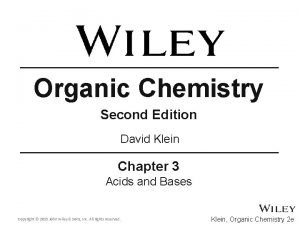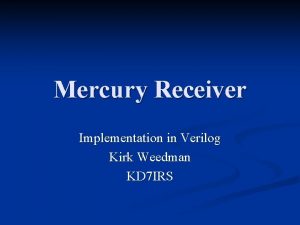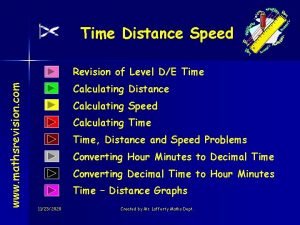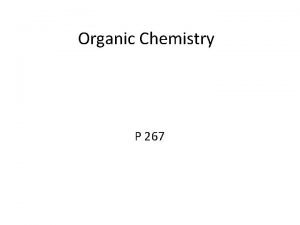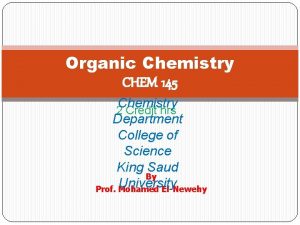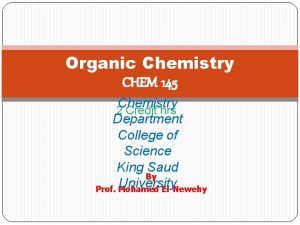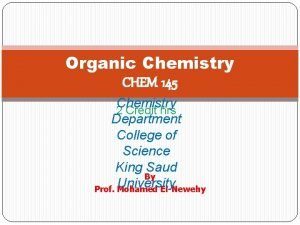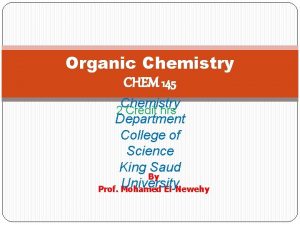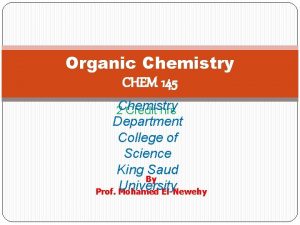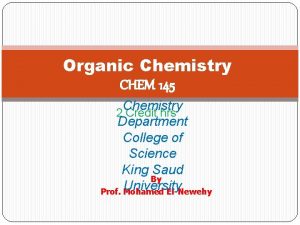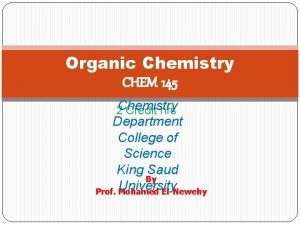Organic Chemistry CHEM 145 Chemistry 2 Credit hrs






















- Slides: 22

Organic Chemistry CHEM 145 Chemistry 2 Credit hrs Department College of Science King Saud By University Prof. Mohamed El-Newehy

Bonding, Structural Formulas, and Molecular Shapes

Organic Chemistry: Definition Organic Chemistry is unique in that it deals with � vast numbers of substances, both natural and synthetic. clothes, the petroleum products, the �The paper, rubber, wood, plastics, paint, cosmetics, insecticides, and drugs. �But, from the chemical makeup of organic compounds, it was recognized that one constituent common to all was the element carbon. �Organic chemistry is defined as the study of carbon/hydrogen-containing compounds and their derivatives.

The Uniqueness of is unique about �What Carbon carbon? does it form �Why the element so many compounds? The answers lie. The in structure of the carbon � � atom. position �The of carbon in the periodic table. �These factors enable it to form strong bonds with �other carbon atoms �and with other elements (hydrogen, oxygen, nitrogen, halogens, …etc).

Atomic Structure consist �Atoms of three main particles: neutrons (have no charge), protons (positively charged) and electrons (negatively Neutronscharged). and protons are found in the � nucleus. �Electrons are found outside the nucleus. Electrons are distributed around the nucleus in successive shells (principal energy levels). �Atom is electrically neutral. i. e. Number of electrons = Number of protons number of an element is the number of �Atomic protons. �The energy levels are designated by capital letters (K, L, M, . . ). The. N, maximum capacity of a shell = 2 n 2 electrons. � n = number of the energy level. �For example, the element carbon (atomic number 6) Shell Number of electrons K 2 L 4 M 0 N 0

Atomic Structure Valance Electrons: Electron-Dot Structures �Valance Electrons are those electrons located in the outermost energy level (the valance shell). �Electron-dot structures �The symbol of the element represents the core of the atom. �The valance electrons are shown as dots around the symbol.

Chemical Bonding �In 1916 G. N. Lewis pointed out the noble gases were stable elements and he ascribed that: their lack of reactivity to their having their valence shells with electrons in case of � 2 filled 8 electrons �helium. for the other noble gases. According to Lewis, � in interacting with one another atoms can achieve a greater degree of stability �This by rearrangement of the valence electrons to acquire the outer-shell structure of the closest noble gas in the periodic table. can be achieved in either of two ways: A) Ionic Bonding through transfer of electrons between atoms. B) Covalent Bonding sharing through of electrons

Chemical Bonding A) Ionic Bonding �Elements at the left of the periodic table give up their valance electrons and become +ve charged ions (cations). �Elements at the right of the periodic table gain the electrons and become -ve charged ions (anions). �Ionic bond The electrostatic force of attraction between oppositely charged ions. �The majority of ionic compounds are inorganic substances.

Chemical Bonding B) Covalent Bonding �Elements that are close to each other in the periodic table attain the stable noble gas configuration by sharing valence electrons �Covalent bond between them. The chemical bond formed when two atoms share one of electrons. Apair shared electron pair between two atoms or single � covalent bond, will be represented by a dash (-). �In molecules that consist of two like the bonding electrons are shared atoms; equally (both atoms; have the same two unlike �When electronegativity). the bonding electrons are no longer shared equally (shared unequally).

Chemical Bonding B) Covalent Bonding A polar bond covalent A bond, in which an electron pair is shared unequally. The more electronegative atom assumes a partial negative charge and the less electronegative atom assumes a partial positive charge. Coordinate Covalent Bonding molecules in which one atom supplies both �There are electrons to another atom in the formation of a covalent bond. example; �For

Chemical Bonding �Lewis The species that furnishes the electron pair to form a base coordinate covalent bond. �Lewis acid The species that accepts the electron pair to complete its valance shell. How Many Bonds to an Atom? Covalence Number The number of covalent bonds that an atom can form with other � i. e. the covalence number is equal to the number of electrons �atoms. needed to fill its valance shell. Element number H C N O Number of electrons Covalence electrons in filled valence shell 1 4 5 6 2 8 8 8 1 4 3 2

Shapes of Organic Molecules: Orbital Picture of Covalent Bonds Atomic Orbitals �An atomic orbital represents a specific region in space in which an electron is most likely to be found. �Atomic orbitals are designated in the order in which they are filled by the letters s, p, d, and f. �Examples K shell has only one 1 s orbital. L shell has one 2 s and three 2 p (2 px, 2 py and 2 pz). An s orbital is spherically shaped electron cloud with the � atom’s nucleus and its center. :

Shapes of Organic Molecules: Orbital Picture of Covalent Bonds Atomic Orbitals is a dumbbell-shaped electron cloud with the �A p orbital nucleus between the two lobes. �Each p orbital is oriented along one of three perpendicular coordinate axes (in the x, y, or z direction). �An energy level diagram of atomic orbitals.

Shapes of Organic Molecules: Orbital Picture of Covalent Bonds Atomic Orbitals When filling the atomic orbitals, keep in mind that � (1) An atomic orbital contain no more 2 electrons. (2) Electrons fill orbitals of lower energy first. (3) No orbital is filled by 2 electrons until all the orbitals of equal energy have at least one electron. �The electronic configuration of carbon (atomic number 6) can be represented as 1 s 22 s 2 sp 1 x 2 p 1 y or 1 s 22 p 2

Shapes of Organic Molecules: Orbital Picture of Covalent Bonds Molecular Orbitals � A covalent bond consists of the overlap between two atomic orbitals to form a molecular orbital. �Example: Molecular orbital of H 2 �Sigma bonds ( bonds) can be formed from �The overlap of two s atomic orbitals. �The end-on overlap of two p atomic orbitals. �The overlap of two an s atomic orbital with a p atomic orbital. pi bonds (π bonds) can be formed from the side-side � overlap between two p atomic orbitals.

Bond Energy and Bond Length �A molecule is more stable than the isolated constituent This stability is apparent in the release of energy during atoms. the formation of the molecular bond. �Heat of formation (bond energy) The amount of energy released when a bond is formed. dissociation Bond � energy The amount of energy that must be absorbed to break a bond. Bond length � The distance between nuclei in the molecular structure.

sp 3 Hybridization: the Tetrahedral Carbon Methan. Shapes of Organic Molecules e formula CH 4. �Molecular �The four carbon-hydrogen bonds is identical. The same strength, 101 kcal/mole, and length, 1. 09 A. tetrahedron with all H-C-H bond angles of �Regular 109. 5º. �The tetrahedron is a pyramid-like structure with the carbon atom at the center and the four attached atoms located at a corner.

sp 3 Hybridization: the Tetrahedral Carbon Methan Shapes of Organic Molecules e �The electronic configuration of the isolated or ground-state carbon. 1 s 22 px 12 p Equivalent 1 y to

Acid-Base Concept �In the Brønsted–Lowry definitions (1923), an acid is a species that donates a proton, and a base is a species that accepts a proton (or any compound possessing a lone pair). �Example: Hydrogen chloride (HCl) meets the Brønsted–Lowry definition of an acid because it donates a proton to water. Water meets the definition of a base because it accepts a proton from HCl. In the reverse reaction, H 3 O+ is an acid because it donates a proton to Cl-, and Cl- is a base because it accepts a proton from H 3 O+.

�When a compound loses a proton, the resulting species is called its conjugate base. Thus, Cl- is the conjugate base of HCl, and H 2 O is the conjugate base of H 3 O+ Thus, HCl is the conjugate acid of Cl- and H 3 O+ is the conjugate acid of H 2 O �Acidity is a measure of the tendency of a compound to give up a proton. Basicity is a measure of a compound’s affinity for a proton.

Lewis Acids and Bases �In 1923, G. N. Lewis offered new definitions for the terms “acid” and “base. ” He defined an acid as a species that accepts a share in an electron pair and a base as a species that donates a share in an electron pair. �Lewis acid such as aluminum chloride (Al. Cl 3) boron trifluoride (BF 3) and borane (BH 3). The term “acid” is used to mean a proton-donating acid, and the term “Lewis acid” is used to refer to non-proton-donating acids such as Al. Cl 3 or BF 3. �All bases are Lewis bases because they have a pair of electrons that they can share, either with an atom such as aluminum or boron or with a proton.

Functional Groups portion of an organic molecule, an atom, or a group �is a reactive of atoms that confers on the whole molecule its characteristic properties. Class Alkane Alkene Alkyl halide Alcohol Ether Aldehyde Ketone Carboxylic acid Ester Amine General formula RH R – CH = CH 2 RX R – OH R – O –R’ R – NH 2 Functional group Specific C – C (single bond) C = C (double bond) (triple bond) -X (X = F, Cl, Br, I) -OH - C- O – C - H 3 C – CH 3 H 2 C = CH 2 H 3 C - Cl H 3 C - OH H 3 C – O – CH 3 H 3 C – NH 2
 Why a day has 24 hours
Why a day has 24 hours Hex hept oct non dec
Hex hept oct non dec Ario organic chem
Ario organic chem Inorganic chemistry vs organic chemistry
Inorganic chemistry vs organic chemistry Ib chemistry organic chemistry
Ib chemistry organic chemistry Bitgain 24 hrs
Bitgain 24 hrs Hrs
Hrs Hrs types
Hrs types 1300 hrs
1300 hrs Hrs
Hrs 24 hour format time
24 hour format time Receive and resolve customer complaints
Receive and resolve customer complaints Nh road cross section
Nh road cross section Wake up stroke
Wake up stroke Navigation compass
Navigation compass Hrs rand
Hrs rand Speed tdst
Speed tdst Eztable taiwan
Eztable taiwan 1300 hrs
1300 hrs This can be avoided by giving credit where credit is due.
This can be avoided by giving credit where credit is due. Separation scheme of caffeine from vivarin tablets
Separation scheme of caffeine from vivarin tablets C5h12
C5h12 Chapter 22 review organic chemistry section 1 answers
Chapter 22 review organic chemistry section 1 answers


